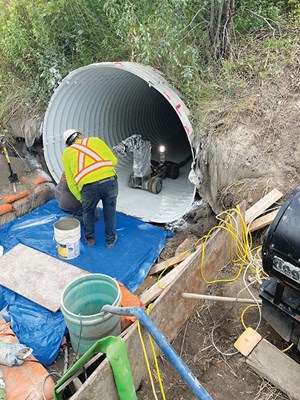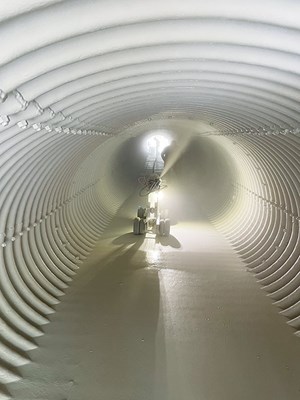May 2023 Vol. 78 No. 5
Rehab Technology
Rehab technology: Canada’s King Road culvert rehab provides structural spray-on solution
Corinna Hunt | Contributing Editor
(UI) — Beneath four lanes of traffic on King Road in York, Ontario, Canada, a deteriorated ellipse culvert needed rehabilitation. Now, the original structure will continue to deteriorate but is no longer cause for concern.

“York region will be monitoring it over the course of years to check the future performance,” said Paul Waldron, a construction inspector for York region and site inspector for the project. “We’re anticipating not having to replace it too soon.”
The culvert is in good shape for the future with the application of two products designed by Nukote Coating Systems. Nukote PP300 is a structural plural-component polyurea polyurethane hybrid designed to carry a load, so it’s harder but with flexibility. Nukote ST-M is a pure polyurea elastomeric, which is better suited to handling impact and abrasions.
Put together – with PP300 against the existing pipe and ST-M as the surface that comes into contact with effluent flowing through the pipe – the products bond monolithically into one solid piece.
“We’re using the pipe in the ground, in this case the culvert, to be a mold, if you will,” said Michael Osborne, president of Nukote. “The existing culvert that’s failing can continue to fail and when the host pipe structure ceases to exist, we become the pipe.”
The initial project bid, won by Aqua Tech Solutions, was for a cementitious product, which is typically sprayed on, according to Waldron. Aqua Tech proposed the use of Nukote polyurea, explaining the benefits and that it’s a relatively new product in Ontario.
Nukote Coating Systems first approached the city of Toronto in 2019 about reviewing its PP300 structural liner. Trials conducted in July and December 2019 went well, and when this project was tendered, York Region, which borders Toronto and is considered part of the greater Toronto area, was already familiar with the trials.
“It’s kind of a multi-year build-up of getting the product and lining system recognized and then accepted for use within the region,” said Aidan Logan, a sales representative for IMC Distributors, the US-based company’s distributor in Canada.
When Aqua Tech won the tender for this culvert rehabilitation project, York Region leadership decided to allow it to proceed with using the polyurea. “This was, as far as I know, the first culvert in York Region that has been sprayed with polyurea,” Waldron said.

Alternatives
Since complete replacement of the culvert would have significantly disrupted pedestrian and road traffic, trenchless techniques were selected to avoid the need for extensive excavation.
“It’s a major arterial roadway in York Region,” Waldron said of King Road. “In York Region there’s a general policy that we do not close roads for construction, and a culvert job such as this would require a lot longer period of work – having to do it in two parts, as in getting the one side of the road and then the other side of the road.”
At the location of the culvert, King Road has two lanes of vehicular traffic – which includes an average daily amount of 26,700 cars annually – with tapering left turn lanes, sidewalks and guide rails on both sides, Zhu said. The top of the culvert is more than 10 feet below the road surface.
Alternatives to the Nukote products typically include cement mortar linings of varying design thicknesses, or cured-in-place pipe lining.
“Those are pretty much, in this application, the two types of things we compete with traditionally,” Osborne explained.
Other methods include pulled-in-place. That involves rigid liners, designed from plastic or rubber, and with a certain engineered thickness, being pulled-in-place in one piece and then grout is pumped around them to hold them in place.
“Those options are a little more onerous because they disturb the environment,” said Osborne. “To do that, we have to excavate and have big equipment to get them in, and we worry about damage to the environment from concrete, mixing and things like that. The less you disturb the environment the better, and we can go in the existing opening without a lot of that going on.”
While Osborne referred to the surrounding infrastructure environment, the natural environment also had to be taken into consideration. The culvert has creek beds situated at both exits, and Fisheries and Oceans Canada had concerns around which products would be used for the rehabilitation, according to IMC Distributors.
“There is a lot of wildlife in the area,” said Karli Logan, IMC president. “These are ANSI/NSF 61 certified, where some of the other systems aren’t considered as environmentally friendly as this particular system is.”
Because of that certification, these products are acceptable for use in potable water lines. Fisheries and Oceans Canada was concerned about damage to aquatic life upstream or downstream of the work site, Osborne stressed, and the project profile notes the organization reviewed and approved the Nukote products.
Feasible alternatives evaluated for this project included sliplining a corrugated steel pipe liner or a high-density polyethylene liner, but both would have required installing an overflow pipe via microtunneling to meet the Ministry of Transportation of Ontario’s highway drainage design criteria.
“The spray liner solution at King Road was the most cost-effective alternative and had a shorter duration of construction than other evaluated solutions,” said Shu Zhu, senior project manager for York Region-Capital Planning and Delivery.
Application
The onsite work took roughly a month from start to finish, including environmental restoration.
“One of the challenges was there was a considerable amount of soil and debris in the culvert, approximately 4.6 feet deep, which needed to be removed and the culvert cleaned prior to the coating,” Waldron said. “That was probably the largest hurdle in the job, but other than that, the project went pretty smoothly.”
Aqua Tech Solutions handled the cleaning. As a large construction company, it had the equipment necessary to do it efficiently.
Once the culvert interior was ready, the Nukote PP300 and ST-M products were sprayed on robotically rather than manually – a system developed throughout the past decade.
“What you’ve got is an A and B component – and they don’t cure,” explained Osborne. “There’s no evaporation, like with paint; there are no solvents that drive the evaporation, they’re 100-percent solids. And they come through the machine behind this robot that takes it to 165 degrees Fahrenheit and mixes it in a gun at the tip of this robot, and then it cures in, in this case, four seconds. We’re applying and driving over it.”
The robotic application system is very functional for two reasons. First, it’s more cost-effective, decreasing the amount of time the contractor must spend on the project. Second, it reduces consumption, meaning less material, less crew days, and less health and safety issues. For safety reasons, clients prefer not to have manpower inside a pipe underneath a roadway, Osborne emphasized.
Because the Nukote polyurea hardens so quickly, it can be an efficient alternative to a spray-on concrete product, which generally takes about two days to harden, Waldron explained.
An inch of PP300, or about 25 millimeters, along with 2 millimeters of ST-M, was applied, according to the project profile. The York Region had concerns of the liner thickness impacting flow through the culvert, but calculations indicated the liner’s smooth surface would lead to a 5-percent increase in flow.
Also, no increase in the water level upstream of the culvert is anticipated under regional storm conditions.
“This culvert is a secondary culvert, so there’s a primary culvert, which the main waterway flows through,” Waldron said. “This culvert is at a higher elevation, so when the water rises in a high-water event, it carries the excess water, so it doesn’t have a blind stream flowing through it constantly.”
Looking ahead
The design life for Nukote products is typically 50 to 75 years, depending on the client’s needs. The King Road culvert lining solution should last for 50 years and is warranted for 25.
Karli Logan praised Nukote’s involvement as a manufacturer.
“Nukote is there throughout the entire process, and I think that’s important,” she said. “You’re putting together a long-term, 50- to 75-year lifespan design and you want to make sure it’s done correctly. Nukote really excels in that area.”
Nukote is already working to launch a new robotic system that can put down twice as much product 10 times as fast as the system in use, which is limited to 3 feet per minute with a 60-milliliter tank.
“What that’s going to do is translate to clients a lower cost for each project so they can do more within the budget they have. We want to deliver what [the client] pays for,” said Osborne.
For York Region, it was a positive experience.
“As a region, I think we would consider the product for other culverts as they show that it can be done efficiently and they have the proper equipment to do it,” said Waldron. “As a lot of our culvert infrastructure is aging, it’s an applicable solution.”
The area is growing rapidly, and the York Region is one of the largest populated. “The region tends to be more proactive when it comes to our roads and infrastructure,” he added.
FOR MORE INFORMATION:
Nukote Coating Systems, (832) 770-7100, nukoteglobal.com




Comments